mind your manner[下学期]
文档属性
| 名称 | mind your manner[下学期] |
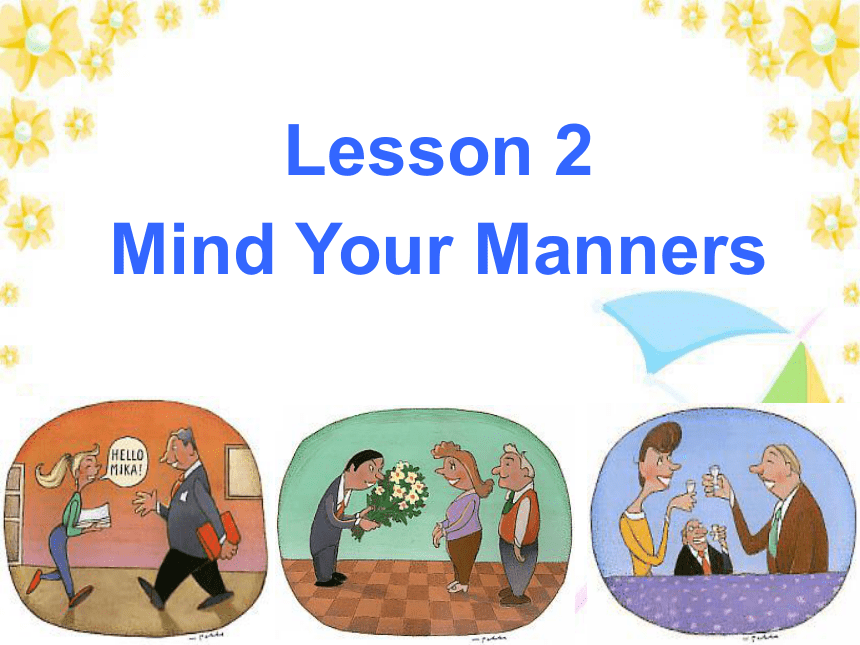
|
|
| 格式 | rar | ||
| 文件大小 | 1.1MB | ||
| 资源类型 | 教案 | ||
| 版本资源 | 北师大版 | ||
| 科目 | 英语 | ||
| 更新时间 | 2006-05-13 10:14:00 | ||
图片预览

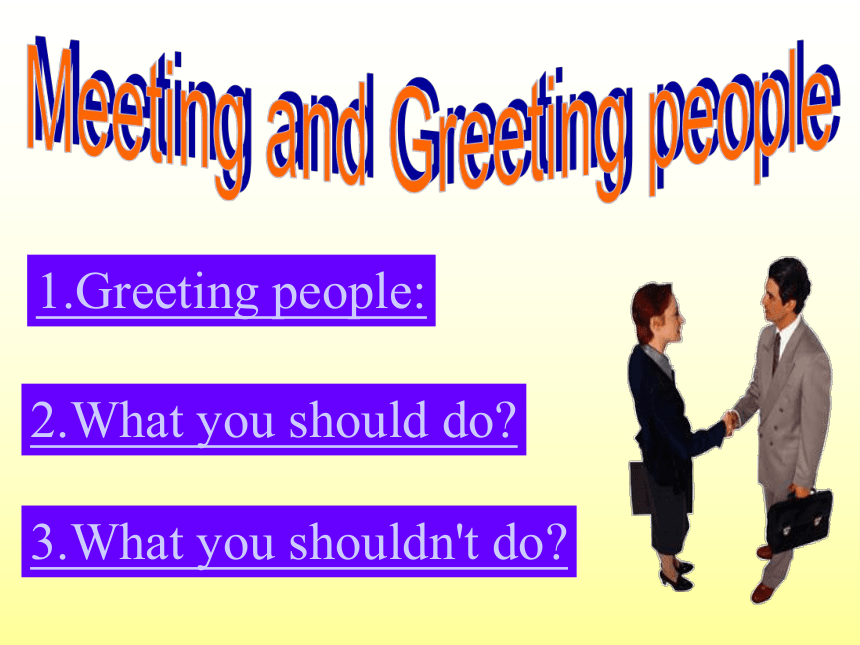

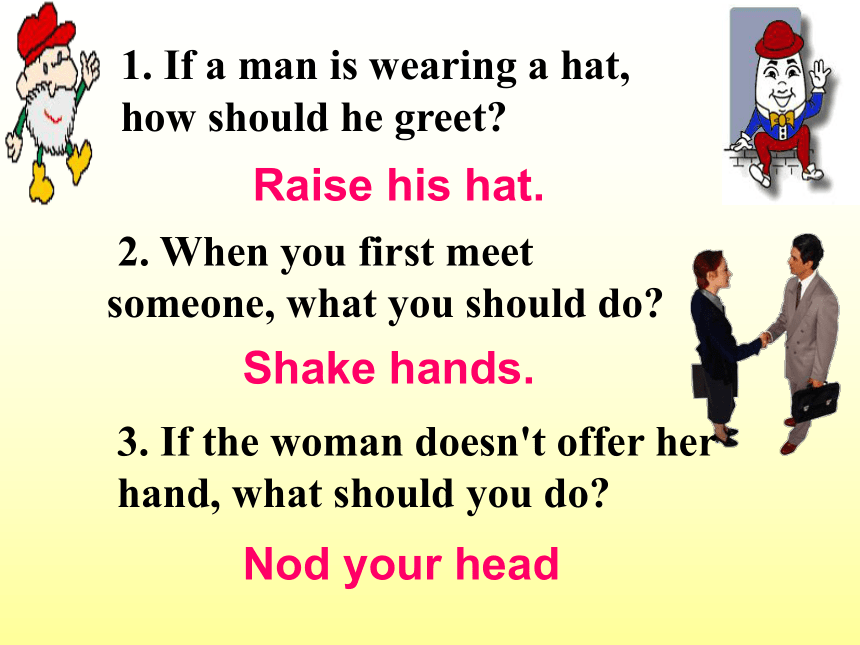

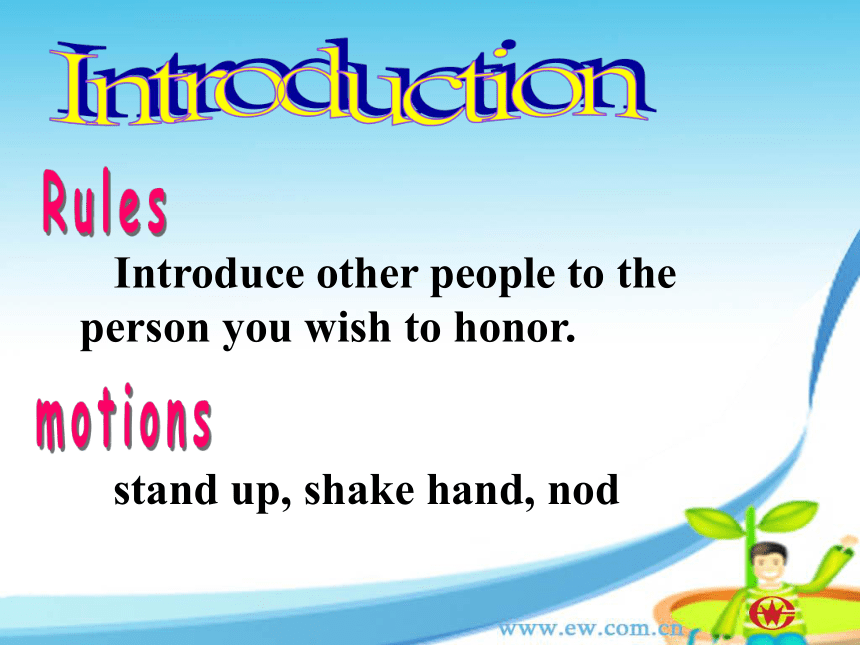
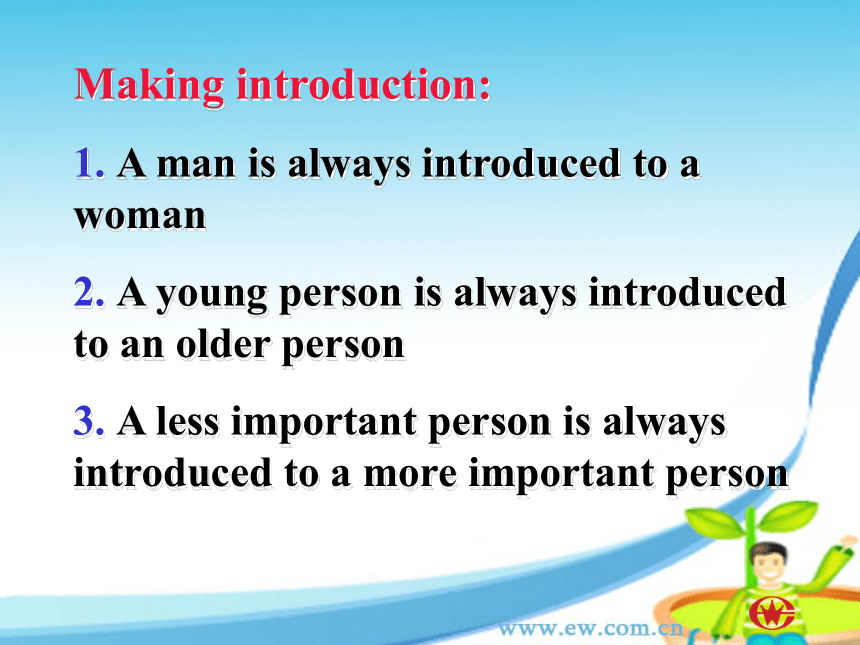
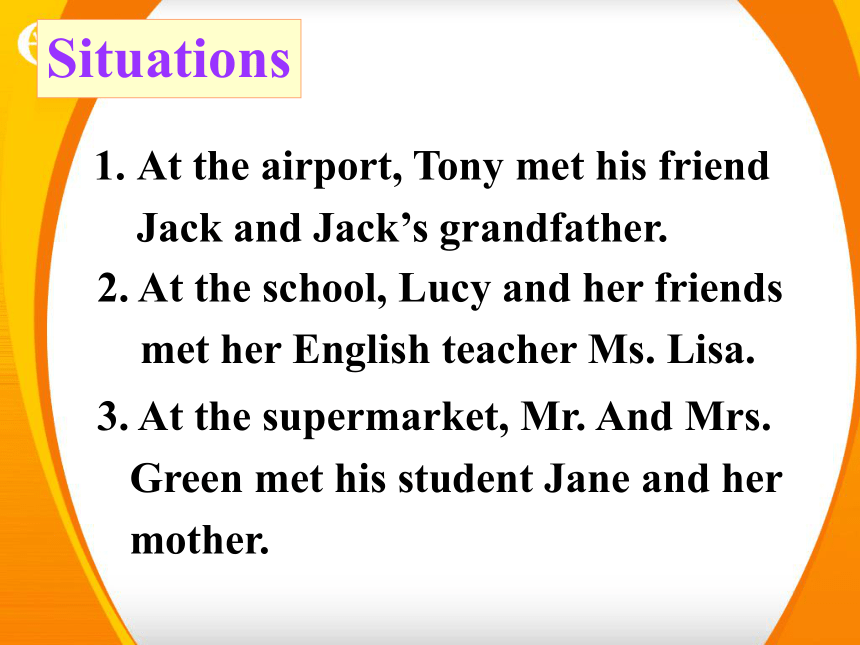

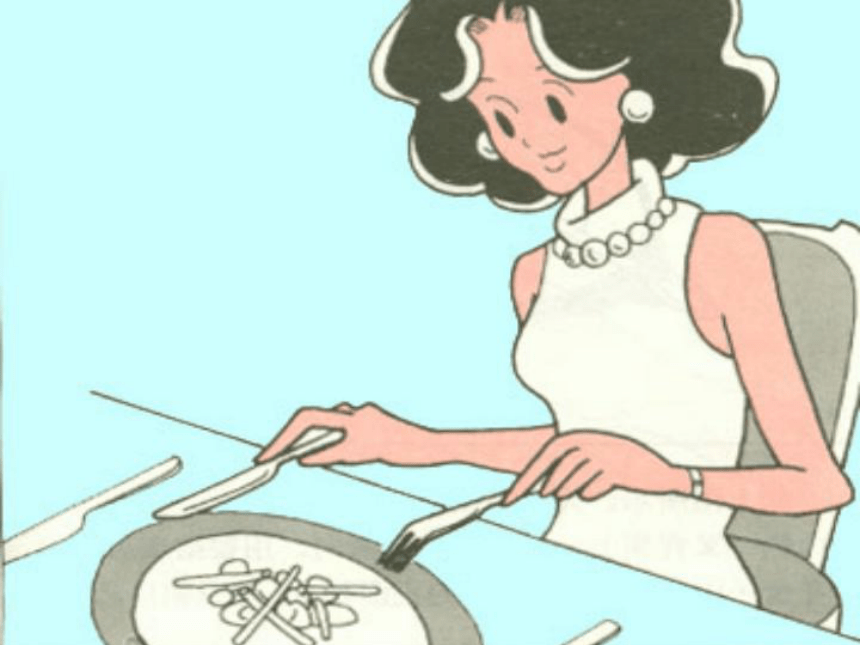

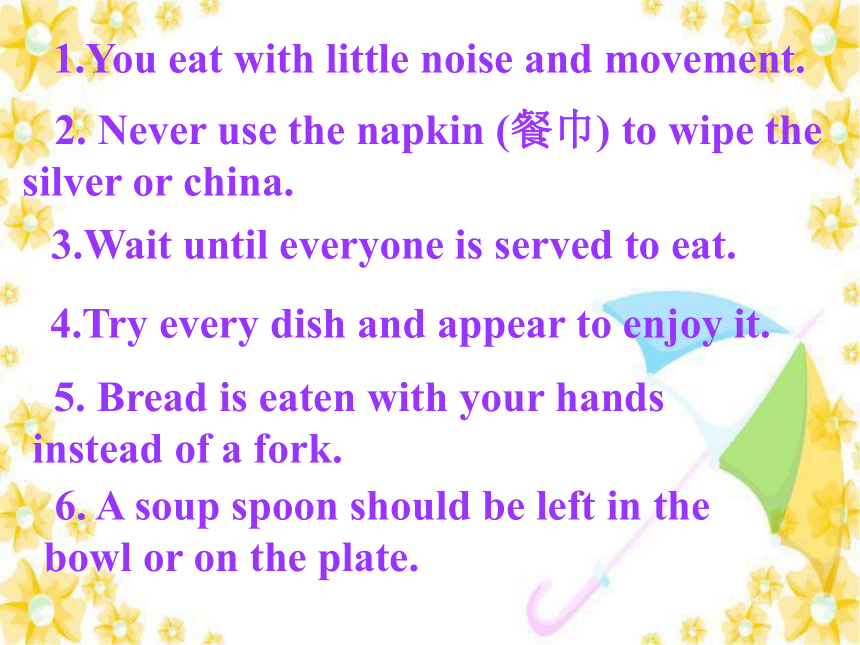
文档简介
课件39张PPT。Lesson 2
Mind Your MannersMeeting and Greeting people1.Greeting people:2.What you should do?3.What you shouldn't do?Good morningGood afternoonGood eveningHow do you do?HelloHow are you?Raise his hat.1. If a man is wearing a hat, how should he greet? 2. When you first meet someone, what you should do?3. If the woman doesn't offer her hand, what should you do?Nod your headShake hands.Shaking hands:Adults offer hands to children first
A woman offers her hand first
3. An older person initiates(begins) a handshake with a younger one
4. The more important person is the first to offer his or her handIntroduction Introduce other people to the person you wish to honor. stand up, shake hand, nodRulesmotionsMaking introduction:
1. A man is always introduced to a woman
2. A young person is always introduced to an older person
3. A less important person is always introduced to a more important personAt the airport, Tony met his friend
Jack and Jack’s grandfather.Situations 2. At the school, Lucy and her friends
met her English teacher Ms. Lisa. 3. At the supermarket, Mr. And Mrs.
Green met his student Jane and her
mother.Table Manners 1.You eat with little noise and movement. 2. Never use the napkin (餐巾) to wipe the silver or china. 3.Wait until everyone is served to eat.4.Try every dish and appear to enjoy it. 5. Bread is eaten with your hands instead of a fork. 6. A soup spoon should be left in the bowl or on the plate.7. Do not put a lot of food in your mouth at one time.8. Drink only when there is no food in your mouth. 9. Try not to get your lips greasy when drinking.10. Do not drop any food in the table cloth. 11. Do not make any noise while eating. 12. Keep your lips closed while you are chewing.Listen to Part 2 of the interview and complete the table. TapescriptPresenter: Good morning and welcome to “Culture Matters”. Today we’re looking at different styles of communication in different cultures. We have Dr Jan Groot, from Utrecht University in Holland in the studio.Expert: Good morning.
Presenter: Can you tell us what the main differences are in the way people around the world communicate?
Expert: Well, one of the main differences is between cultures that express how they feel-let’scall them “open” cultures- and others which generally try not to show their feelings-let’s call them “closed” cultures. People from “open” cultures generally show how they feel quite openly-when they are happy, or when they are angry. “Closed” cultures avoid showing their feelings, especially in more serious situations, such as at school, university or work. People from “closed” cultures are usually quieter and seem shyer and more modest than people from “open” cultures.
Presenter: Which cultures, then, are “open” and which are “closed”?Expert: Mm, people from Latin cultures usually show their feelings more-for example, the Italians. When asked if they would show that they were angry at work, 71% of Italians indicated that they would show this openly.Presenter: And what about “closed” cultures?
Expert: Eastern cultures and northern European cultures do not show their feelings as much. For example, only 17% of the Japanese would show anger openly at work. And only 29% of the British would show they were angry.Presenter: I see.
Expert: Curiously enough, the Americans are more like the Italians-over 60% would express anger openly in a work situation. Culturally, Americans are in between “open” and “close” cultures-in some ways they are more “open” and in other ways they are more “closed”.Ex. 4 Listen and match the pictures with the dialogues.1. D 2. B
3. A 4. CTapescriptPresenter: What differences are there in the way people actually express themselves-using hand movements and that sort of thing?Expert: Well, people from “open” cultures, like the Italians, tend to use a lot more hand movements, you know, using not only their hands but their arms. People in more “closed” cultures, like the Japanese, Northern Europeans and even Americans, don’t use hand movements nearly as much.Presenter: Mm, yes.
Expert: Also, people from “open” cultures usually look more directly at the person they are speaking to. The British and Americans often look at people to start with and then they look away. People from Eastern cultures like Japan, never look directly at the other person. To look at someone very directly is extremely rude.
Presenter: And what about speaking?Expert: Right, well people from “open” cultures are more likely to interrupt or speak at the same time as the other person. In “closed” cultures, one person starts speaking only when the other has stopped. In a place like Japan, people never interrupt each other. They also wait for a while before speaking, so there is more silence.
Presenter: Finally, what about manners. What differences are there?
Expert: Well, Japanese and British people might seem more polite than Americans and people from Latin cultures. British people usually use “please”, “thank you” and “I’m sorry” more often. In Britain, it is very important to say “please”and “thank you”, even for the smallest things. If you don’t, it sounds very rude. In other cultures, like Latin cultures, to say “please” and “thank you” all the time sounds a bit false.Presenter: I see. Well, thank you very much Dr Groot. That was fascinating. I’m afraid we’ll have to stop there. Tomorrow we’ll be…Ex.5 Listen to the dialogues and complete the Function File. 2. 3.
5. 6.
8. 9.
10. 11. pleaseThank you welcomeratherExcuse mecouldmindkindtroublereally sorry promiseEx. 6 Make a list of the expressions in the Function File we use. 1. Excuse me? Could you pass the lemon and salt, please?
2. You’re welcome.
3. I’d rather not, thanks.
4. Do you think I could have a word with you?
5. Thanks a lot. That’s very kind of you.
6. oh, I’ve forgotten it! I’m really sorry.abcdefEx.7 Listen to the dialogues again. This time Christina sounds rude. Why? 1. b 2. 3. 4. dacVocabulary Complete the verbs in the dialogue below with these words:up with, on, back, off, up Pete: Hey, Anne? Are you going to the canteen?
Anne: Well, I’m going (1) _____ home. I’m in a bit of a hurry.
Pete: Do you think you could drop me (2) ___ at the mailbox?backoffAnne: OK, but hurry (3) ___, I’ve got to pick (4) ___ my twin sisters in twenty minutes.
Pete: Great! Hang (5) ___ a second. I’ll just get my bag.
Anne: I’m going to the courtyard. Catch (6) _______ me there!upon up withup
Mind Your MannersMeeting and Greeting people1.Greeting people:2.What you should do?3.What you shouldn't do?Good morningGood afternoonGood eveningHow do you do?HelloHow are you?Raise his hat.1. If a man is wearing a hat, how should he greet? 2. When you first meet someone, what you should do?3. If the woman doesn't offer her hand, what should you do?Nod your headShake hands.Shaking hands:Adults offer hands to children first
A woman offers her hand first
3. An older person initiates(begins) a handshake with a younger one
4. The more important person is the first to offer his or her handIntroduction Introduce other people to the person you wish to honor. stand up, shake hand, nodRulesmotionsMaking introduction:
1. A man is always introduced to a woman
2. A young person is always introduced to an older person
3. A less important person is always introduced to a more important personAt the airport, Tony met his friend
Jack and Jack’s grandfather.Situations 2. At the school, Lucy and her friends
met her English teacher Ms. Lisa. 3. At the supermarket, Mr. And Mrs.
Green met his student Jane and her
mother.Table Manners 1.You eat with little noise and movement. 2. Never use the napkin (餐巾) to wipe the silver or china. 3.Wait until everyone is served to eat.4.Try every dish and appear to enjoy it. 5. Bread is eaten with your hands instead of a fork. 6. A soup spoon should be left in the bowl or on the plate.7. Do not put a lot of food in your mouth at one time.8. Drink only when there is no food in your mouth. 9. Try not to get your lips greasy when drinking.10. Do not drop any food in the table cloth. 11. Do not make any noise while eating. 12. Keep your lips closed while you are chewing.Listen to Part 2 of the interview and complete the table. TapescriptPresenter: Good morning and welcome to “Culture Matters”. Today we’re looking at different styles of communication in different cultures. We have Dr Jan Groot, from Utrecht University in Holland in the studio.Expert: Good morning.
Presenter: Can you tell us what the main differences are in the way people around the world communicate?
Expert: Well, one of the main differences is between cultures that express how they feel-let’scall them “open” cultures- and others which generally try not to show their feelings-let’s call them “closed” cultures. People from “open” cultures generally show how they feel quite openly-when they are happy, or when they are angry. “Closed” cultures avoid showing their feelings, especially in more serious situations, such as at school, university or work. People from “closed” cultures are usually quieter and seem shyer and more modest than people from “open” cultures.
Presenter: Which cultures, then, are “open” and which are “closed”?Expert: Mm, people from Latin cultures usually show their feelings more-for example, the Italians. When asked if they would show that they were angry at work, 71% of Italians indicated that they would show this openly.Presenter: And what about “closed” cultures?
Expert: Eastern cultures and northern European cultures do not show their feelings as much. For example, only 17% of the Japanese would show anger openly at work. And only 29% of the British would show they were angry.Presenter: I see.
Expert: Curiously enough, the Americans are more like the Italians-over 60% would express anger openly in a work situation. Culturally, Americans are in between “open” and “close” cultures-in some ways they are more “open” and in other ways they are more “closed”.Ex. 4 Listen and match the pictures with the dialogues.1. D 2. B
3. A 4. CTapescriptPresenter: What differences are there in the way people actually express themselves-using hand movements and that sort of thing?Expert: Well, people from “open” cultures, like the Italians, tend to use a lot more hand movements, you know, using not only their hands but their arms. People in more “closed” cultures, like the Japanese, Northern Europeans and even Americans, don’t use hand movements nearly as much.Presenter: Mm, yes.
Expert: Also, people from “open” cultures usually look more directly at the person they are speaking to. The British and Americans often look at people to start with and then they look away. People from Eastern cultures like Japan, never look directly at the other person. To look at someone very directly is extremely rude.
Presenter: And what about speaking?Expert: Right, well people from “open” cultures are more likely to interrupt or speak at the same time as the other person. In “closed” cultures, one person starts speaking only when the other has stopped. In a place like Japan, people never interrupt each other. They also wait for a while before speaking, so there is more silence.
Presenter: Finally, what about manners. What differences are there?
Expert: Well, Japanese and British people might seem more polite than Americans and people from Latin cultures. British people usually use “please”, “thank you” and “I’m sorry” more often. In Britain, it is very important to say “please”and “thank you”, even for the smallest things. If you don’t, it sounds very rude. In other cultures, like Latin cultures, to say “please” and “thank you” all the time sounds a bit false.Presenter: I see. Well, thank you very much Dr Groot. That was fascinating. I’m afraid we’ll have to stop there. Tomorrow we’ll be…Ex.5 Listen to the dialogues and complete the Function File. 2. 3.
5. 6.
8. 9.
10. 11. pleaseThank you welcomeratherExcuse mecouldmindkindtroublereally sorry promiseEx. 6 Make a list of the expressions in the Function File we use. 1. Excuse me? Could you pass the lemon and salt, please?
2. You’re welcome.
3. I’d rather not, thanks.
4. Do you think I could have a word with you?
5. Thanks a lot. That’s very kind of you.
6. oh, I’ve forgotten it! I’m really sorry.abcdefEx.7 Listen to the dialogues again. This time Christina sounds rude. Why? 1. b 2. 3. 4. dacVocabulary Complete the verbs in the dialogue below with these words:up with, on, back, off, up Pete: Hey, Anne? Are you going to the canteen?
Anne: Well, I’m going (1) _____ home. I’m in a bit of a hurry.
Pete: Do you think you could drop me (2) ___ at the mailbox?backoffAnne: OK, but hurry (3) ___, I’ve got to pick (4) ___ my twin sisters in twenty minutes.
Pete: Great! Hang (5) ___ a second. I’ll just get my bag.
Anne: I’m going to the courtyard. Catch (6) _______ me there!upon up withup
